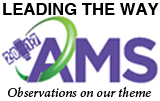Richard Jackson: “And by the way: political leaders are REALLY good at maps. Map your data.” #AMS2017
— Jared Brewer (@BrewRed) January 23, 2017
This point was made at Monday’s Presidential Forum, where Dr. Richard Jackson of UCLA was talking about how much our scientific community offers to the world of public health, and how we might best be able to move decision makers to action based on climatic information.
It is good news. Nobody makes maps more eagerly than meteorologists.
Hardly a session goes by at the AMS Annual Meeting without some sort of map—often of some unexpected variable. For example, today at 10:45 a.m. (Skagit 4), Yonghua Wu (City Univ. of New York) and colleagues pull together trajectory modeling, lidar ceilometer, and satellite observations to map air quality variations due to the interaction of boundary layer conditions with wildfire smoke plumes this past summer over New York City.
 Then on Thursday (1:45 PM, Tahoma 2), you can map the New York City area again, in a completely new way: Sina Kashuk of NOAA shows spatial density maps of the 5 million flood-related phone calls across the five boroughs.
Then on Thursday (1:45 PM, Tahoma 2), you can map the New York City area again, in a completely new way: Sina Kashuk of NOAA shows spatial density maps of the 5 million flood-related phone calls across the five boroughs.
Using the top 25 most frequent complaint types ranging from noise to rats, the overall propensity of calling was estimated and mapped. This map was then used to normalize the flood-related complaints. The temporal-spatial analysis was highly correlated with monthly rainfall intensities.
Clearly, no place is mapped in one particular way. Maps say as much about the data and the analysis as about the specific location. Mapping is thus an essential tool for coalescing, analyzing, contemplating, and communicating observations.
Harvard historian Peter Galison takes this point a step further in his studies of the history of observing as evinced by map-making. Through a selection of atlases across the centuries, all made by scientists, he shows how the powers of observation and the expectations and capabilities of science are all intertwined, and all evolving. The idea of observing itself is not the same today, he shows, as it was in Newton’s time or even in Einstein’s. In this lecture from 2011 he uses the atlases to trace the history of objectivity itself in mapping:
Which brings us warily to the title of a presentation this morning (8:30 AM, Room 611) , “Beyond Maps-How Cloud Computing Enables the Future of Geospatial Analysis Services.” Presenter Steve Kopp of ESRI explains:
[W]e now see a technology transformation that is enabling deeper understanding, and will lead to new insights and new discoveries. Early adoption of geospatial cloud computing focused on organizing and sharing data….Map services (a picture of the data) are symbolized data ready to view, and require fewer specialized skills than working with raw data such as GRIB files. More recently organizations have begun providing weather and climate data services. These are feature services like WFS and image services like WCS. Data services allow customization of the symbology and more flexibility in visually combining with other data, but also can be used for analysis allowing the user to ask new questions with the data. The transition to data services feeding into analysis services will have a profound impact on the utility and growth of geospatial cloud computing.
Perhaps someday historians will see this AMS Annual Meeting as a part of shift that led the way to yet another stage in the growth of science itself.